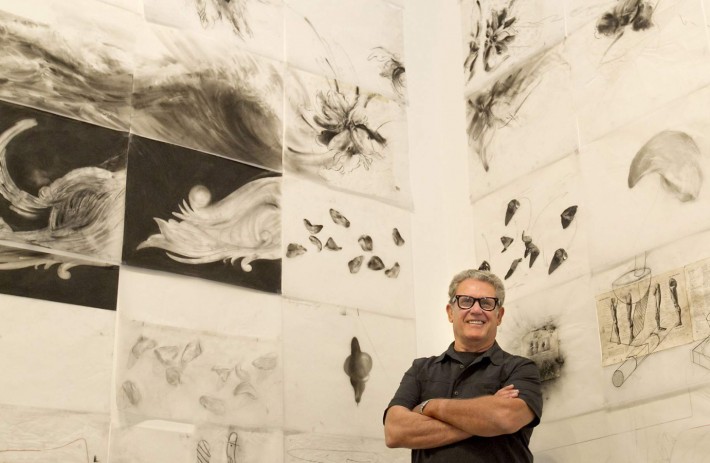By Jeanne Claire Van Ryzin via bendbulletin.com

Already an accomplished, critically-acclaimed Texas artist, James Drake in 2012 gave himself the challenge to draw every day for two years. Drake drew an astonishing 1,242 individual drawings depicting wild animals, landscapes, studies of human anatomy, scientific formulas, and representations of classical art and family photographs. [Laura Skelding / Austin American-Statesman]
Each morning, the 68-year-old leaves his house outside Santa Fe, New Mexico, and drives into town, listening to National Public Radio. He stops at the same place to buy coffee and a New York Times.
And then Drake — whose work is collected by museums nationwide and who has represented the United States in the prestigious Venice Biennial, among many other career accolades — drives back to his house, which is his studio. And in his studio, the artist gets to work for the day, his black Labrador typically at his feet.
With its mixture of discipline and whimsy, Drake’s imaginative commute, as it were, embodies everything behind “Anatomy of Drawing and Space (Brain Trash),” the sprawling installation of 1,242 drawings on display through Jan. 4, 2015, at the Blanton Museum of Art in Austin, Texas.
Elegant, yet frenetic, “Brain Trash” mashes up dichotomies. It brims with references to art history as well as to science, public events and Drake’s biography.
Exquisitely rendered depictions of animals and landscapes literally overlap with scientific equations. The swirling clouds of a hurricane vortex sweep next to a neat axon-metric diagram of a mechanical system. Abstract Rorschach-like images give way to almost photo-realistic drawings of Drake’s family pictures.
Splayed out across the museum walls, the unframed drawings are arranged in 10 chapters. “Brain Trash” is as casual in its presentation and free-form in its nature as it is ultimately very formal.
The exhibit is organized by the Museum of Contemporary Art San Diego, where it made its debut this summer.
In 2012, the Texas-born Drake — whose oeuvre is usually known for sculpture and video, though his virtuoso draftsmanship invariably emerges in much of what he does — set himself the challenge of drawing every day.
“I don’t believe in an epiphany, a bolt coming down out of the sky and inspiring you,” says Drake in his gentle West Texas twang as he recently watched museum staff install his art. “If you’re not working, you’re not creating.”
Drake kept the parameters of his drawing challenge simple but stringent. He used 19-inch-by-24-inch paper, a standard size commonly used in art classes. And he used basic drawing materials: graphite pencils, ink, pastel drawing crayon, sometimes employing a little collage or stencil work.
He could draw whatever came to mind and as much as he wanted, but he never skipped a day of drawing. (One sheet bears the words “Nothing Today,” because as Drake laughingly admits, “I just had nothing to draw that day.”) And as the drawings emerged, Drake began to see them organized as chapters. About all that determined the size of each chapter was the size of his studio walls.
As he finished each drawing, he pinned it to his studio wall, arranging each neatly in a tight grid reading left to right, as if every drawing were the syllable of a word or the words in a sentence.
Drake didn’t permit himself to edit or to rework a drawing even though some individual images stretch across a dozen sheets of paper, many shooting horizontally across rows.
“It’s an incredibly impressive accomplishment,” says Annette DiMeo Carlozzi, the Blanton’s curator-at-large. “The pure durational power of this exercise that still continues over several years’ time, the bravura of his draftsmanship, the raw inventiveness of how he treats each sheet of paper, the apparent confidence and self-acceptance behind letting us see what’s in his head.”
And we do literally see inside Drake’s head. Long finding inspiration from science, Drake had an MRI scan of his brain made, enlisting the help of doctor friend to do so. In order to work around hospital procedure, Drake’s doctor friend simply labeled the initial diagnosis on the MRI request as “brain trash.”
For the 10th chapter of drawings, Drake copied the brain scans in exact detail yet at an enormous scale.
“‘Brain trash’ just summed up everything about this project, how I just emptied my head,” Drake says. “I leave it to others to interpret it how they want.”
And yet the masterly drawing of Drake’s project is also a reminder that for all the technological advancements that have put image-making literally into everyone’s hands thanks to smartphones, ultimately artistic accomplishment is the result of hard work, not gadgets and selfies.
“With today’s technology, everyone thinks of themselves as a photographer or an artist or a filmmaker,” he says. “Well, not everybody is. And this is just about drawing — going back to the beginning.”
“Brain Trash” has been Drake’s preoccupation in the last couple of years. And he has no plans to stop drawing. Indeed, he has not stopped drawing every day.
“If you’re not working,” he says, “you’re not growing as an artist.”
